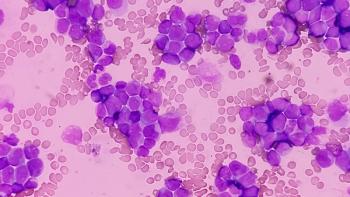
Oncology Nurses Key in Addressing Patient Adherence to Ribociclib Treatment
In patients with advanced breast cancer, oncology nurses play a key role in outcomes by providing education and supporting adherence to a treatment regimen.
In patients with advanced breast cancer, oncology nurses play a key role in outcomes by providing education and supporting adherence to a treatment regimen, according to a poster presented at the Oncology Nursing Society's 43rd Annual Congress held in Washington, DC.
When taken in combination with an aromatase inhibitor (AI), the CDK4/6 kinase inhibitor ribociclib (Kisqali) significantly improves progression-free survival (PFS) in postmenopausal women with hormone receptor-positive, human epidermal growth factor receptor 2 (HER2)-negative advanced or metastatic breast cancer.
But to achieve the maximum benefit of a ribociclib treatment regimen, it is important that patients maintain adherence — which is where oncology nurses can help, Patricia S. Ramos, RN, OCN, said in an interview with Oncology Nursing News.
“Oncology nurses often serve as the first line of communication for patient questions about symptoms and adverse effects,” Ramos wrote. “They may help improve adherence by providing emotional and social support to patients and their families through education about the treatment.”
Ramos first examined the role of ribociclib in regulating cell-cycle progression to help oncology nurses better educate their patients about the drug’s mechanism of action, dosing, efficacy, and safety.
Continuously in combination with an AI, ribociclib is taken orally regardless of food intake at a starting dose of 600 mg per day for 3 weeks, followed by 1 week without a dose, until disease progression or unacceptable toxicity. No dose adjustment is required for patients aged 65 years or older, or for those with mild or moderate renal impairment, or with mild hepatic impairment.
In the
It is important to note, said Ramos, that this data focuses specifically on patients with measurable disease. In patients with immeasurable disease—i.e., bone lesions–whose progress cannot be tracked by tumor growth, it’s important to manage treatment expectations. “As long as you don’t progress, and your quality of life is not decreased by the medication we’re giving you, we consider this a win,” said Ramos.
Adverse effects (AEs) observed with ribociclib were consistent with those found in other similar drugs and most were manageable with dose modification as required. The most common grade 3/4 AEs included neutropenia, leukopenia, abnormal liver function, lymphopenia, and vomiting.
Most AEs occurred within the first 3 months of treatment and were completely treatable with appropriate management.
Ramos noted that, depending on individual tolerability, modification of the treatment dose may be required. In the MONALEESA-2 study, dose reductions due to AEs occurred in 45% of patients, for which the most common reason was experiencing an AE—usually neutropenia. Periodic evaluations of complete blood count, liver function tests, and electrocardiograms are recommended throughout treatment.
Ramos then detailed best practices that oncology nurses can use to support patient adherence to a ribociclib treatment regimen. According to her poster, the practices followed at Redlands Community Hospital, where Ramos is based, illustrate how the oncology nurse can play a vital role in improving patient adherence. These include:
- Recording baseline parameters and discussing medical history: Nurses should screen for preexisting conditions, establish if the patient is comfortable with taking oral drugs, and watch for any gastrointestinal issues that may prevent full efficacy.
- Providing calendars to optimize adherence: Along with serving as a document of all physician, pharmacy, and oncology nurse contact information, Ramos provided an example calendar that patients can also use to track and record AEs and concomitant medications.
- Encouraging adherence through use of community resources: These can include the American Cancer Society, and local and online support groups.
- Maintaining an open line of communication: Communication may influence several factors, including the rate of patient recovery, psychological well-being, and quality of life. Oncology nurses should follow up with patients to ensure that they were able to effectively communicate with their physician, and conversely also pass along any relevant information to the patient’s physician to ensure effective treatment.
- Facilitating collaboration between pharmacies and patients: Serving as a touchpoint between the patient and pharmacy could improve patient care and increase adherence by addressing patient questions, monitoring AEs, and noting any possible interactions with other medications.
Ramos concluded that educating patients on key drug-related data, such as mechanism of action, dosing, efficacy, and safety is essential to maintaining patient adherence to treatment.
“Because patient adherence to dosing regimens is necessary for the maximum treatment benefit, the role of oncology nurses in achieving this goal is indispensable and constantly evolving.”
Reference
Ramos P. Role of oncology nurses in patient education for improving treatment adherence and outcomes in patients with advanced breast cancer. Presented at: Oncology Nursing Society 43rd Annual Congress; May 17-20, 2018; Washington, D.C. Poster-IS22.
Newsletter
Knowledge is power. Don’t miss the most recent breakthroughs in cancer care.
















































































